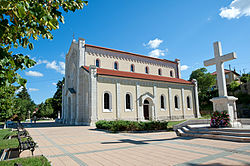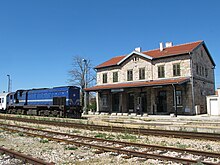Drniš
Drniš | |
|---|---|
| Grad Drniš Town of Drniš | |
 Church in Drniš | |
| Coordinates: 43°51′45″N 16°9′20″E / 43.86250°N 16.15556°E | |
| Country | |
| Historical region | Dalmatia |
| County | |
| Government | |
| • Mayor | Josip Begonja (HDZ) |
| Area | |
• Town | 351.7 km2 (135.8 sq mi) |
| • Urban | 21.3 km2 (8.2 sq mi) |
| Population (2021)[2] | |
• Town | 6,276 |
| • Density | 18/km2 (46/sq mi) |
| • Urban | 2,752 |
| • Urban density | 130/km2 (330/sq mi) |
| Time zone | UTC+1 (CET) |
| • Summer (DST) | UTC+2 (CEST) |
| Climate | Cfa |
| Website | drnis |
Drniš is a town in the Šibenik-Knin County, Croatia. Located in the Dalmatian Hinterland, it is about halfway between Šibenik and Knin.
History
[edit]
The name Drniš was mentioned for the first time in a contract dated March 8, 1494. However, there are traces of an older Middle Ages' fortress built by Croatian aristocrat family Nelipić at the site called Gradina dominating the landscape. The town was conquered by the Ottoman Turks in 1522 due to its strategic location. Many buildings from this time period are still preserved today. During the Baroque period, the mosque built by the Turks was transformed into a church. During Ottoman rule, it was nahiya seat of Petrovo Polje; which initially bounded to Croatian vilayet of Sanjak of Bosnia between 1522 and 1537, laterly to Sanjak of Kilis between 1537 and 1664 and again between 1670 and 1683.[3] Venetian Republic briefly conquered Drniš in 1664 during Cretan War. Ottomans recaptured in 1670. Finally it fell into Venetian hands in 1683 during Great Turkish War. Then, Drniš shared fate of Venetian Dalmatia till 1918. In 1918 the town was occupied by Italian troops who remained there until a withdrawal in 1921, as a result of the Treaty of Rapallo.[4] The town subsequently became a part of the Kingdom of Serbs, Croats and Slovenes.
On September 16, 1991, during the Croatian War of Independence, Drniš was attacked by forces of the 9th Corpus of Yugoslav People's Army and militia of SAO Krajina led by general Ratko Mladić. The Croatian population fled under mortar fire, and town was incorporated in Republic of Serbian Krajina. The town and surrounding Croatian villages suffered extensive demolition and looting in that period. In August 1995, Drniš was restored to Croatian government control during the military action Operation Storm, and the Serbian population fled to Serbia or Bosnia and Herzegovina.
Population
[edit]| population | 11212 | 11653 | 11978 | 12865 | 14843 | 15606 | 14535 | 17502 | 18900 | 19382 | 19538 | 18466 | 15363 | 14733 | 8595 | 7498 | 6276 |
| 1857 | 1869 | 1880 | 1890 | 1900 | 1910 | 1921 | 1931 | 1948 | 1953 | 1961 | 1971 | 1981 | 1991 | 2001 | 2011 | 2021 |
| Population of Drniš municipality | ||||||
|---|---|---|---|---|---|---|
| Year of census | Croats | Serbs | Yugoslavs | Others or unknown | Total | |
| 1991 | 18,732 (77.50%) | 4,974 (19.34%) | 76 (0.32%) | 387 (1.60%) | 24,169 | |
| 2001 | 7,835 (91.16%) | 656 (7.63%) | - | 104 (1.21%) | 8,595 | |
Heritage
[edit]The village of Otavice near Drniš is the place where the noted sculptor Ivan Meštrović spent his childhood. A museum has been built which has an exhibition of the archeological rests from the neolithic and Roman eras, along with Croatian history. The composer Krsto Odak (1888–1965) was born in Siverić near Drniš. The town has a memorial to Julijan Ramljak.[5] The area is also known for its agricultural orientation and a once notable mining center.
Municipal settlements
[edit]In the 2021 census, the population was distributed in the following settlements:[6]
- Badanj, population 233
- Biočić, population 78
- Bogatić, population 71
- Brištani, population 149
- Drinovci, population 124
- Drniš, population 2,752
- Kadina Glavica, population 150
- Kanjane, population 0
- Kaočine, population 201
- Karalić, population 119
- Ključ, population 107
- Kričke, population 185
- Lišnjak, population 4
- Miočić, population 44
- Nos Kalik, population 2
- Pakovo Selo, population 186
- Parčić, population 126
- Pokrovnik, population 190
- Radonić, population 327
- Sedramić, population 168
- Siverić, population 426
- Širitovci, population 127
- Štikovo, population 31
- Tepljuh, population 103
- Trbounje, population 181
- Velušić, population 78
- Žitnić, population 114
Notable natives or residents
[edit]- Božidar Adžija, politician
- Dražen Budiša, politician
- Mihovil Nakić, basketball player
- Ecija Ojdanić, actress
- Milka Planinc, politician; Prime Minister of Yugoslavia (1982–86)
- Stojko Vranković, basketball player
- Ivan Meštrović, sculptor
- Nikanor Ivanović, Bishop of Cetinje and Metropolitan of Montenegro and the Highlands
- Đurađ Jakšić, Serbian historian and politician
References
[edit]- ^ Register of spatial units of the State Geodetic Administration of the Republic of Croatia. Wikidata Q119585703.
- ^ "Population by Age and Sex, by Settlements" (xlsx). Census of Population, Households and Dwellings in 2021. Zagreb: Croatian Bureau of Statistics. 2022.
- ^ Jurin Starčević, Kornelija; 2015, Ottoman Drniš: Census defters, narrative sources and archaeological artifacts as sources for (re)interpretation of Ottoman history in today's Dalmatia, Prilozi za orijentalnu filologiju, Issue: 64, pp. 217-238 (Bosnian article)
- ^ Grad Drink
- ^ Spomenik fra Julijanu Ramljaku, Slobodna Dalmacija
- ^ "Population by Age and Sex, by Settlements" (xlsx). Census of Population, Households and Dwellings in 2021. Zagreb: Croatian Bureau of Statistics. 2022.


